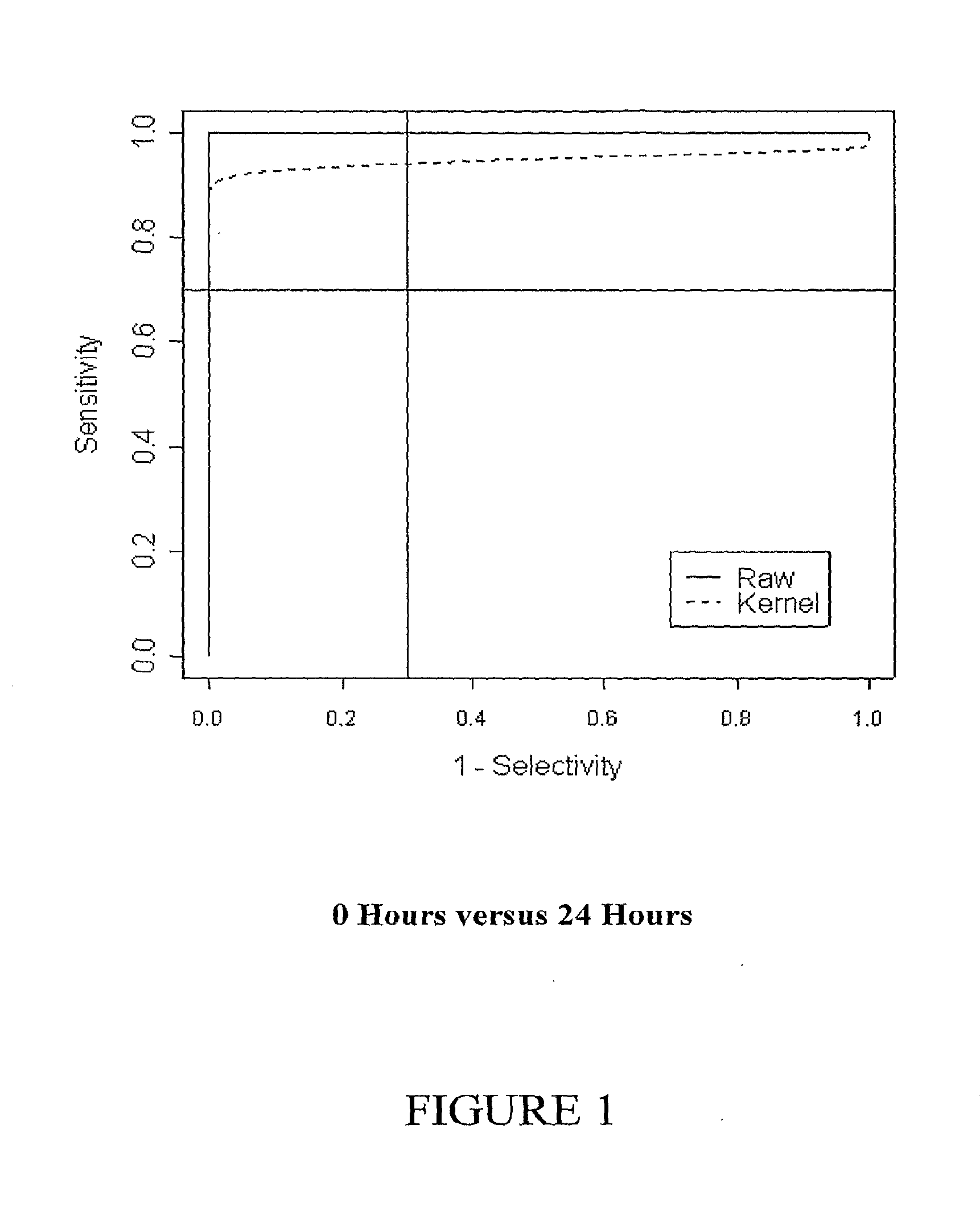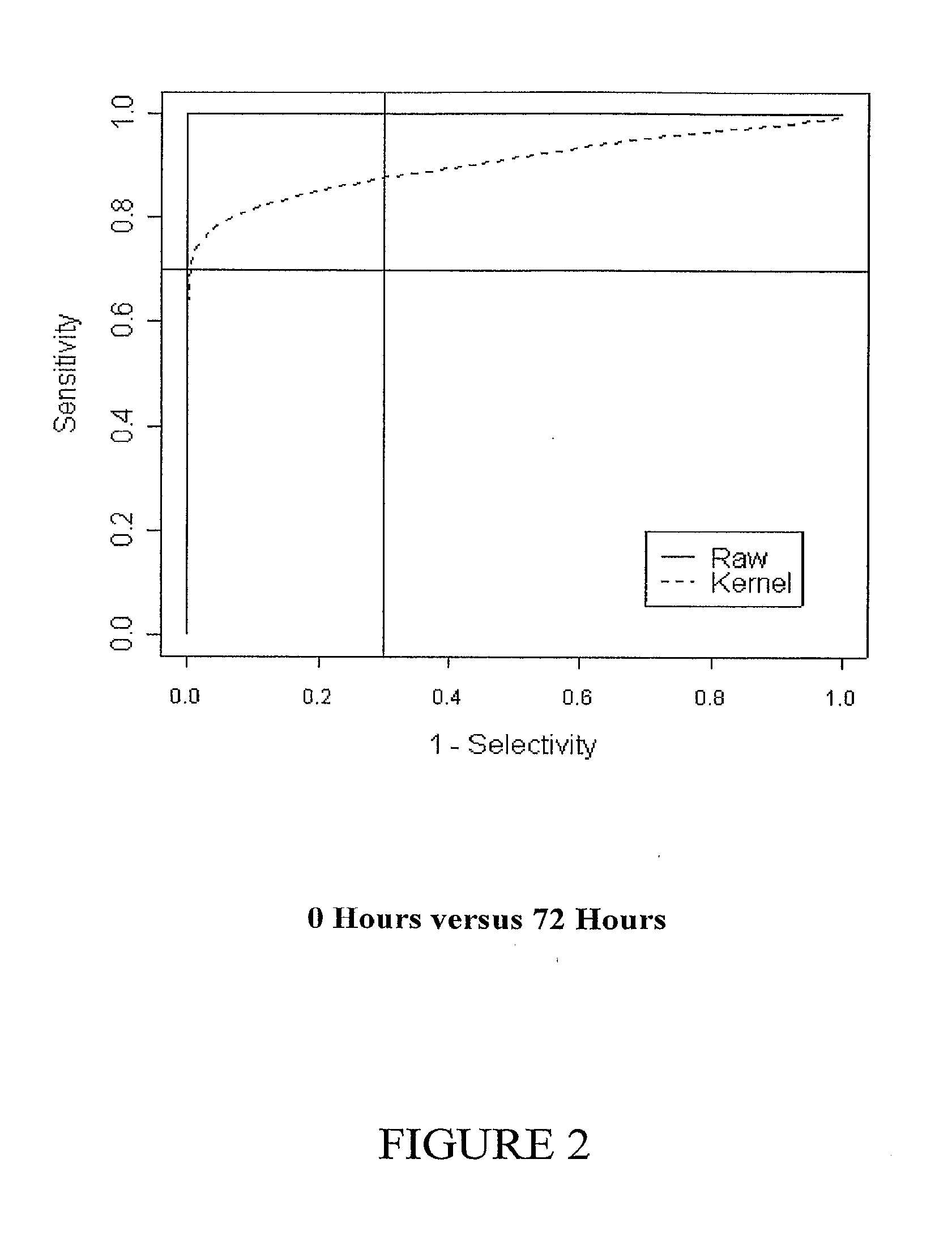Polynucleotide Marker Genes and their Expression, for Diagnosis of Endotoxemia
- Summary
- Abstract
- Description
- Claims
- Application Information
AI Technical Summary
Benefits of technology
Problems solved by technology
Method used
Image
Examples
example 1
Identification of Specific Diagnostic Genes for Endotoxaemia-Related Conditions
Experimental Disease Trial Design
[0255]A clinical trial was performed on three blocks of fours horses each. The first block consisted of four horses that were dosed orally with 12.5 mg / kg of oligofructose2 as part of the trial procedure described by Pollitt3 which is specifically designed to induce endotoxaemia and subsequent acute laminitis. The second block consisted of four horses that underwent the same trial procedure but were dosed with normal saline (0.9%) solution (controls). The same four horses in the second block then underwent the trial procedure (following a period of recovery) for a second time but were dosed with oligofructose (block three). All horses were stalled under the same conditions for the duration of the procedure (120 hours). 2 Raftilose®, Orafti Active Food Ingredients, Aanndorenstraat, B-3300 Tienen, Belgium.3 van Eps A & Pollitt CC. Equine Vet J. 36(3):255-60 (2004).
[0256]Endo...
example 2
Identification of Diagnostic Marker Genes and Priority Ranking of Genes
[0395]For experimental groups, differences in gene expression between animals before and after experimental induction of endotoxaemia were analysed using the empirical Bayes approach of Lonnstedt and Speed (Lonnstedt and Speed, 2002, Statistica Sinica 12: 31-46).
[0396]The objectives were to: (a) identify changes in gene expression during the acute endotoxaemic phase of disease, and (b) evaluate the diagnostic potential of these changes, for detecting enodtoxaemia.
[0397]Comparison between dosed and control horses involved some information which is within horses (i.e. some information is available from the longitudinal comparison of horses which were used both as controls and as treated animals), and some information which is between horses (involving cross-sectional comparisons between horses which were dosed and horses which were not). In addition, some planed samples were not available. The result is an unbalanc...
example 3
Demonstration of Diagnostic Potential to Determine Endotoxaemia
[0406]In addition, the diagnostic potential of the entire set of genes was assessed using discriminant analysis (Venables and Ripley, 2002, Modern Applied Statistics in S, Springer) on the principal component scores (Jolliffe, I. T. Principal components analysis, Springer-Verlag, 1986) calculated from gene expression. The entire process was cross-validated. Sensitivity and specificity were calculated for a uniform prior. This may be interpreted as a form of shrinkage regularization, where the estimates are shrunken to lie in a reduced space.
[0407]Cross-validated discriminant function scores were used to estimate a receiver operator curve. The receiver operator curve was calculated by moving a critical threshold along the axis of the discriminant function scores. Both raw empirical ROCs were calculated, and smoothed ROCs using Lloyd's method (Lloyd, C. J. 1998, Journal of the American Statistical Association 93: 1356-1364...
PUM
| Property | Measurement | Unit |
|---|---|---|
| pH | aaaaa | aaaaa |
| temperature | aaaaa | aaaaa |
| temperature | aaaaa | aaaaa |
Abstract
Description
Claims
Application Information
 Login to View More
Login to View More - R&D
- Intellectual Property
- Life Sciences
- Materials
- Tech Scout
- Unparalleled Data Quality
- Higher Quality Content
- 60% Fewer Hallucinations
Browse by: Latest US Patents, China's latest patents, Technical Efficacy Thesaurus, Application Domain, Technology Topic, Popular Technical Reports.
© 2025 PatSnap. All rights reserved.Legal|Privacy policy|Modern Slavery Act Transparency Statement|Sitemap|About US| Contact US: help@patsnap.com


